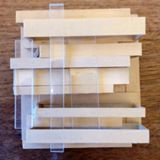Japanese Knot Basket
One characteristic often found in the Japanese baskets that I have studied is the multiple use of a single element or part of a basket; more from less. This leads to an overall artistic richness because singular elements with multiple purposes are by nature more layered, more interesting. For example, a single piece of bamboo can start as a part of the base of a basket, can become part of the rim, turn into the handle, and return to being an upright...all in the same basket. I have one small Japanese Ikebana basket (container for flower arrangements) where one piece of bamboo likely measures 8-10 feet long and changes it's dimension in both its thickness and width multiple times. The thought, creativity, and planning to achieve this astounds me.
This latest basket is of the same ilk. The elements that form the base, and would typically turn up as uprights to hold the weavers to make the basket's sides are bent and twisted and interlocked to form the entirety of the basket. A total of 16 pieces are all that are needed to complete the entire basket. These 16 are the uprights, the weavers, and the rim all in the same. The basket is a special type of weaving where elements are woven above and behind and around each other taking on various roles. In its simplicity it seems to me to move beyond weaving toward sculpture. I find the aesthetic of the 'Knot' as well as its process incredibly rewarding. There is a frugality to the design that is pleasing, bordering on the spiritual. It's like looking at a single petal on a single flower and somehow seeing the entire tree. This frugality of elements also makes the weaving of the basket incredibly quick, from start to finish anywhere from 20 to 40 minutes and the basket is done.
While searching online for images of Japanese baskets I came across a video on YouTube of a Japanese basketmaker demonstrating how to make this particular basket. I cannot speak the language, but a careful study and multiple watchings of the video was enough to learn how to make this special basket. By watching and re-watching of the video, taking notes along the way, I created a working set of instructions for the making of this basket. The basket pictured here is the third iteration of what I am calling a 'Knot' basket, because it very literally starts with a series of granny knots. I don't know what it's actually called in Japanese.
Having read many books and followed other instructions help me to create my own. Of course the actual making of the piece was the greatest instruction. This can be seen from the smallest basket which is a rather overwrought mass, to the third one which is not only larger in scale but cleaner in line and completion. I learned so much through just those three iterations about material, length, tension, review, and patience.
Beyond the frugality mentioned above there are many reasons I like this basket. I'm not adverse to spending time on a basket, in fact I enjoy the rewards of that process and its completion, but there's also something in the simplicity of doing something fairly quickly. It is also a basket I can easily see making for people as a small token of appreciation or love.
Here's a link to the video of the Japanese Basketmaker where I learned this design: https://m.youtube.com/watch?v=z_WQnnGoylE. I appreciate his willingness to share his knowledge and experience.
Within the petal is the essence of the flower; within the flower the tree; and within the tree the entire forest.
